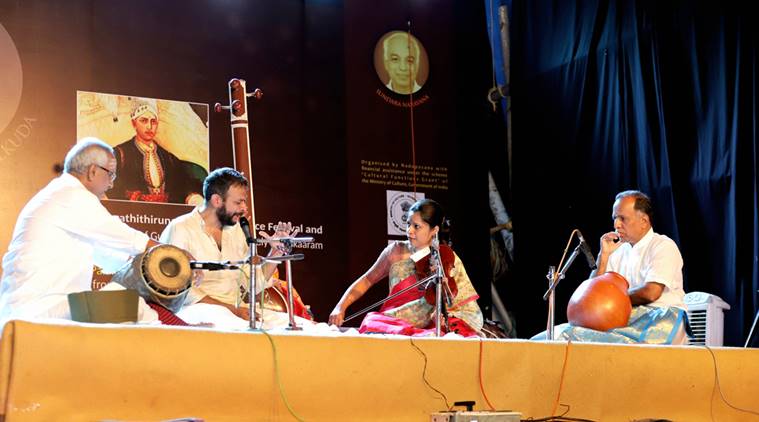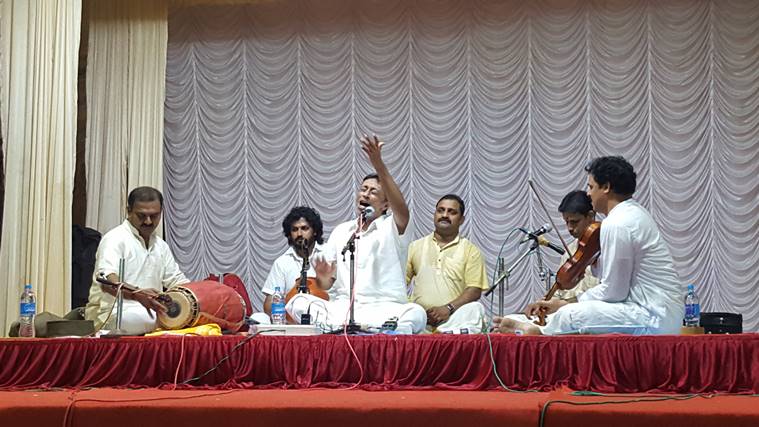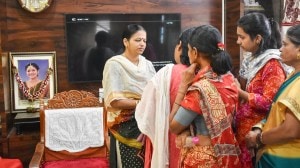- India
- International
Away from Chennai’s margazhi season, Carnatic music finds a welcome home in Kerala’s temples
If on a winter’s night, a raga: Even before the sound of the procession recedes, Subrahmanyan begins to sing a varnam, the customary introductory piece in a Carnatic concert.
 Music As Prayer: TM Krishna in concert with Akkarai Subhalakshmi near a temple in Thrissur; Sanjay Subrahmanyan at the temple in Pathanamthita; and Vishnudev Namboothiri. (Source: G Pramod Kumar)
Music As Prayer: TM Krishna in concert with Akkarai Subhalakshmi near a temple in Thrissur; Sanjay Subrahmanyan at the temple in Pathanamthita; and Vishnudev Namboothiri. (Source: G Pramod Kumar)
On a hot May night, the atmosphere at the Omallur Rakthakanda Swamy temple in Pathanamthitta district in southern Kerala is electric. Caparisoned elephants, blazing fire torches, piercing panchavadyam and the cacophony of milling crowds are part of the 10-day annual festival at this gorgeous eighth-century temple.
A few metres away, Sanjay Subrahmanyan, the superstar of Carnatic music, has taken the stage in his trademark crisp whites. Even before the sound of the procession recedes, Subrahmanyan begins to sing a varnam, the customary introductory piece in a Carnatic concert. The pandal is full of people. Some are seated on plastic chairs, some on the floor. A drunk man makes several rounds right in front of the stage. It’s never going to be as quiet as a concert hall. Close to midnight, Subrahmanyan begins an elaborate Mohanam and moves on to a thrilling rhythmic duel with the mridangam player. An energetic Shanmughapriya raga in praise of Lord Shiva and a Natanamakriya evoking the homegrown god Lord Ayyappa, keep the audience rapt well past 1 am. It’s a classic Kerala temple concert.
In the popular imagination, Chennai is the capital of Carnatic music, the city where the stars are born, live and perform. A city that’s synonymous with the margazhi season, when several hundred people sing and thousands listen, day after day. But margazhi is on only for about a month. As the city’s music goes into slumber for the rest of the year, musicians become itinerant performers. An unmissable place in their concert tours are the temples in nearby Kerala.
 Concerts are held in about 3,000 temples managed by the five Devaswom boards and hundreds of others run by families, communities and trusts.
Concerts are held in about 3,000 temples managed by the five Devaswom boards and hundreds of others run by families, communities and trusts.
It’s a little-known fact that after Chennai, Kerala (along with possibly Bengaluru) is the biggest market for Carnatic music in India. Unlike Chennai, the temple-concert season in Kerala lasts as long as six months: from November-December to May.
Concerts are held in about 3,000 temples managed by the five Devaswom boards and hundreds of others run by families, communities and trusts. The festival concerts are held across the state, from Kasargode at the northern tip to Thiruvananthapuram in the south.

“Performing in Kerala is a unique experience. People seem to be rooted in music. Nowhere else would you see the general public, not necessarily connoisseurs, stay up late for hours on end to listen to classical music,” says Akkarai Subhalakshmi, the famous violinist-vocalist and a regular in the Kerala circuit.
Noted vocalist Saketharaman says he finds the unbridled enthusiasm of the audiences refreshing. “The artiste can enjoy along with everyone else in the audience. The shake of the heads, murmurs, and sometimes the aggressive thala beating — all these add so much lustre to the concert.”
 Besides the open spaces and the festive atmosphere, what make the temple concerts in Kerala unique are the timing and the largely lay, but expressive, listeners.
Besides the open spaces and the festive atmosphere, what make the temple concerts in Kerala unique are the timing and the largely lay, but expressive, listeners.
Sandeep Narayan, a leading musician of the younger generation, says, “Singing in these huge temple spaces for large moving audiences taught me how to engage rasikas with varying tastes, and how to keep people awake at midnight. Once, on our way to our hotel after finishing a concert at Cochin at about 2 am, we were stopped by the temple guard. I thought he would ask for some money, but all he wanted was to tell me that he enjoyed the concert and asked if I could sing his favourite Chakkani Raja next time!”
Besides the open spaces and the festive atmosphere, what make the temple concerts in Kerala unique are the timing and the largely lay, but expressive, listeners. As Vishnudev Namboothiri, another top-billed Chennai-based musician, says, “Since most of these concerts start after 10 pm, you need to build your experience in singing for long durations at late hours.” Vocalist Kunnakudi Balamuralikrishna recalls how he was intrigued by this late-night fervour in his first concert in Kerala at a temple near Palghat. “The concert started at 10.30 pm and people enthusiastically stayed on till 1.30 am or so. Probably, I was the only one who felt tired.”
Musicians love singing in Kerala for another reason too. There, people love their Todis, Mohanams, Kambojis, Sankarabharanams and Kalyanis; and Sindhubhairavis, Bhagesris, Yamunakalyanis, Neelambaris and Yadukulakambojis more than unfamiliar ragas and wouldn’t mind listening to the same compositions again and again. In fact, some of them might even be disappointed if the singers omit any of them and try lesser known ragas or compositions that the Chennai audiences prefer. They also love ragas with a lot of rakthi (that gives pleasure) and those adopted from Hindustani Classical music. Probably, because their listening repertoire is not anywhere close to that of the connoisseurs in Chennai, they seek joy within a familiar space. For the same reason, for a Chennai sabha regular, some of these concerts might appear light.
Another interesting feature of the Kerala audience is their affinity to percussion. Nowhere else in India does a thaniyavarthanam (the percussion solo) get such appreciation and ovation. Saketharaman notices it every time he performs in the state: “They love the rhythmic aspects a lot more. Their appreciation of laya is the best I have seen anywhere in the world.”
The Kerala temple-concert tradition has lasted decades, while in Tamil Nadu it has largely disappeared. Carnatic music was generously patronised by the Travancore royalty as early as the 19th century and singers from the then Tamil Nadu region were held in high esteem in the state. The establishment of the Swathi Thirunal Academy of Music in Thiruvananthapuram in 1939 also saw a steady stream of stalwarts training local students and performing in the state.
Tamil Nadu, too, had such elaborate temple concerts, but probably because of the socio-political transformation of the 20th century, they dwindled. Now Carnatic music in the state is mostly confined to the sabhas and temples in Chennai and a handful of places such as Coimbatore, Trichy and Madurai. It’s also a result of the exclusive (Brahminical) nature of the genre.
Many stalwarts of Carnatic music — GN Balasubramaniam, Semmangudi Srinivasa Iyer and Madurai Mani Iyer — have regularly performed at Kerala temples over the years. The older generation still speaks about its marathon concerts. Scores of people preserve bootleg temple recordings of masters and contemporary singers the way Steve Jobs treasured his Bob Dylan tapes.
By the end of May, the temple festival season in Kerala will come to a close, but the concerts will still continue through a handful of sabhas and music festivals. There’s never a lean period. And that’s another story.
Apr 26: Latest News
- 01
- 02
- 03
- 04
- 05








































